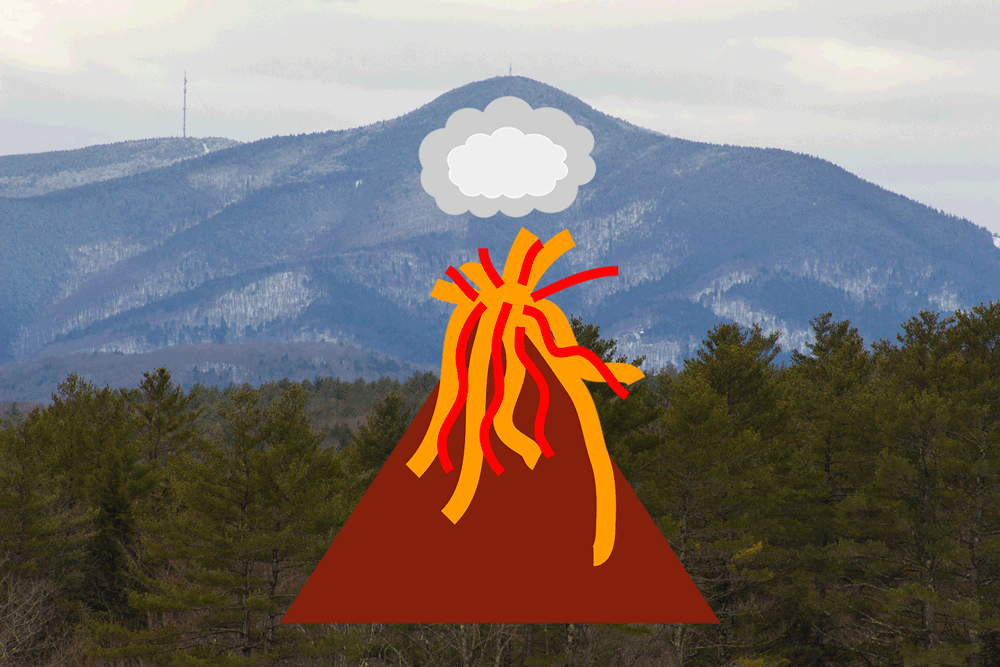On the eastern side of the Cornish-Windsor Covered Bridge is a small dirt parking lot. It’s sandwiched between the Connecticut River and Route 12A.
This is where I meet Cheryl Cox, who lives in nearby Weathersfield. She suggested this spot for its view of Mount Ascutney.
Mount Ascutney is marbled blue and brown in the distance. The middle of its long ridgeline is a rounded little point.
And about a week before I met Cheryl, based on what I could find on the internet, I definitely thought it was a dormant volcano.
"And it does look like a volcano," Cheryl says. "Just its pointiness. And you know, even on the other side of it, if you're coming up through Weathersfield, it almost looks like there could be a crater there. It looks it. But the rocks that it's made of tell us something different."
More from Brave Little State: How Has The Geology Of Vermont Affected Its Character?
Cheryl has a master’s degree in geology. She also spent years teaching math and science. And she is here to say that Mount Ascutney is not a volcano, and never was.
But: Mount Ascutney is in all likelihood related to a volcano no longer in existence. More on that later.

First: rocks.
“I have some rocks in the car to show you," Cheryl tells me.
From a box in her trunk, she pulls out a rock the size of a plum. It’s light gray with tan flecks and black specks running all through it. It’s called syenite.
Syenite is an igneous rock — that means it was made out of magma, that wicked hot, orange liquid stuff from beneath the earth’s surface.
“This one is from Ascutney," Cheryl says. "Ascutney has larger grains of minerals in it."
Those larger mineral grains are there, she says, because the magma the rock is made of cooled over a long period of time, underground.
And what that tells us is, Mount Ascutney also originally formed thousands of feet below the earth’s surface. About 120 million years ago.
“Ascutney is called a stock," Cheryl says. "A stock is a small pluton."
Picture a chocolate lava cake. It’s all made from the same stuff, but the surface of it is exposed to the oven first, and so it bakes solid. Meanwhile, the inside of it stays cooler, and is still gooey. A pluton — in this case, the early life of Mount Ascutney — is the gooey inside part. And unfortunately, it’s not made of chocolate but of magma, so don’t eat it.
"So it would have been underground," Cheryl says. "And it would have fed — magma would have poured up above and fed a volcano."
In this extended Mount-Ascutney-as-cake metaphor, volcano = solid surface of baked lava cake. (Though again, not made of chocolate, but other igneous rocks formed by rapidly-cooled magma.)
"They're made out of ash, cinder, obsidian, glass, lava, that sort of stuff," Cheryl says. "And that would have been eroded away. And this is what we would have had left."
"This" being Mount Ascutney. When I ask Cheryl if there's any way to definitely know if there was a volcano once on top of it, she says "probably."
"Because of evidence in other places around," Cheryl says.
Evidence like some volcanic rock left behind and eventually embedded in the syenite rock making up Mount Ascutney. And then additional volcanic activity further down in Massachusetts and Connecticut.

Geologist Jon Kim with the Vermont Department of Environmental Conservation confirmed that Mount Ascutney indeed started out millions of years ago as an underground, gooey magma mass.
He also said it could have fed a volcano that would have been on a ground surface more than a mile higher than the current earth surface today.
That extra mile-plus of rock, Kim added, has since eroded away, which is how we’re left with a 3,144-foot above-ground mountain.

Cheryl Cox says because a lot of Vermont’s geological record HAS been lost to erosion, there is a lot we can only imagine about what things looked like here 200, 300, 400 million years ago.
But some things are certain based on what’s left here. And one of those things is that Mount Ascutney was never a volcano.
“To me, it's a stock," Cheryl says. "It is what it is. And I go by what the rocks tell me.”
And rocks, it turns out, can tell a lot.
Music in the audio story provided by Blue Dot Sessions.
Have questions, comments or tips? Send us a message.





